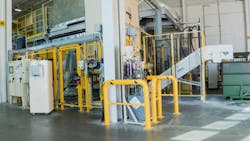The contrast between foundries and diecasters has always been clear to those involved in metalcasting: foundries fill molds with molten metal, controlling the speed, chemical reactions, and other process details to achieve optimal filling, solidification, etc.; diecasters “force” molten metal into a mold cavity (the “die”), using pressure to achieve filling. There are dozens of other process distinctions — but to casting buyers these are not major considerations. They want well-formed parts formed with metallurgical certainty, mechanical soundness, and excellent surface qualities. As a result, many parts that because of size or material would once have been produced only by foundries have been converted to diecastings.
So, the increasing number of automotive parts specified as diecastings by automotive buyers represents a trend, but it also reaffirms the diecasters’ expertise at producing quality parts in high volumes. And, this trend has resulted in a significant total of capital investment in large, high-pressure diecasting systems to produce castings for automotive OEMs and suppliers.
Also driving automotive designers toward diecastings has been the ongoing effort to make vehicles lighter and more fuel-efficient. The ability to diecast complex parts in aluminum and nonferrous alloys, now in larger dimensions, is an ideal match for this automotive prerogative.
The trend reached a new peak in April with the commissioning of a BuhlerPrince high-pressure diecasting system at Mercury Castings, in Fond du Lac, WI. The 4,500-ton, 4575CCA diecasting machine is the largest HPDC system operating in North America.
Mercury Castings is an operating unit of Mercury Marine, the world-renowned manufacturer of recreational marine engines. It produces aluminum castings by high-pressure diecasting and lost foam casting, for Mercury Marine programs as well as manufacturers of automotive, agricultural, and industrial systems.
“This new machine positions us to make castings that no one else in the industry can do,” according to Mike Meyer, Mercury Castings general manager, speaking at the commissioning last month. “With this new machine, Mercury can make larger, lightweight structural components and reduce the overall weight of our engine by producing more efficient castings.”
That is, in addition to casting a range of new structural automotive parts, the new HPDC machine positions Mercury Castings to produce larger, structural components for high-horsepower Mercury Marine engines.
Mercury ordered the machine in mid 2015, with BuhlerPrince explaining at that time that the new system would provide the ability to produce the automotive sector’s largest structural parts, and parts for other industries where lighter designs are needed to address fleet vehicle carbon-emission reductions, to achieve better fuel efficiency, or both.
BuhlerPrince, Holland, MI, is an operating division of the Swiss manufacturer Buhler Die Casting. It designs machines with clamping force ranging from 200 to 4,500 tons, and offers retrofit and/or remanufacturing services, spares parts, and service and support for diecasters in North America.
Installation at the Wisconsin plant began in 2016. A cross-functional team of operators worked to coordinate the installation, which included not only the BuhlerPrince machine, but also the related civil works, environmental controls, and automation that supports the high-pressure diecasting process.
The new machine has 75 inches of free space between the tie bars, space that Mercury Castings will use to expand the dimensions of its in-house casting capability. Relatedly, the machine is able to receive molten-metal shots up to 200 lbs., and has a closing force of 4,500 tons.
The HPDC is supplied with pressurized hot water (up to 300°F) and high-pressure jet cooling (flow rates up to 500 PSI), with over 100 water lines to keep the diecast tooling in “thermal equilibrium” during the process.
An integrated emissions-capture system draws in steam and vapors from the diecasting process, filtering those emissions before being re-introducing clean air to the plant. Mercury Castings claims the system maintains “the cleanest environment in the industry for our operators.”
Three ABB Robotics units attend the machine in an integrated production process that includes robotic pouring, robotic die-lube spraying, and robotic part extraction from the machine.
The automated capabilities also include overflow detection (preventing damage to tooling and equipment), liner insertion, and degating. Automated degating is important, because the larger-size castings now possible represent an ergonomic risk to operators lifting and handling the parts.
Further, beside the larger and lighter castings, the new machine allows Mercury Castings to produce multi-part castings that previously were not possible.
“This new, state-of-the-art casting machine on our campus gives us the opportunity to continue to drive growth for the business,” stated John Pfeifer, Mercury Marine president.
About the Author
Robert Brooks
Content Director
Robert Brooks has been a business-to-business reporter, writer, editor, and columnist for more than 20 years, specializing in the primary metal and basic manufacturing industries. His work has covered a wide range of topics, including process technology, resource development, material selection, product design, workforce development, and industrial market strategies, among others.
